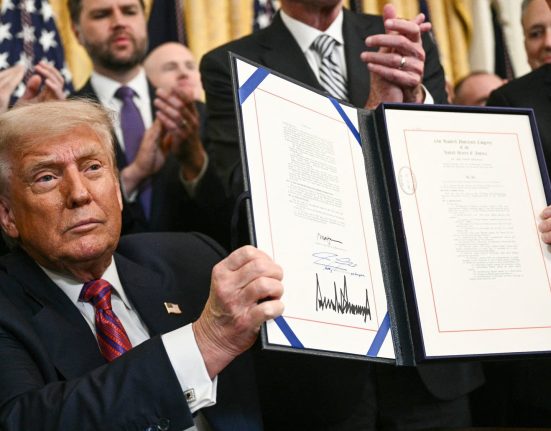Bitcoin (BTC 0.96%) is the world’s largest cryptocurrency. It has a market capitalization of $1.8 trillion as of this writing, representing more than half of the total value of all coins and tokens in circulation across the industry, which currently stands at $2.9 trillion.
MicroStrategy (MSTR 5.20%) co-founder Michael Saylor thinks there is still substantial upside ahead, because he predicts Bitcoin will reshape the entire financial system thanks to its decentralized nature, its capped supply, and its secure system of record called the blockchain. According to his forecast, Bitcoin could skyrocket by 13,800% by 2045, to reach $13 million per coin.
Saylor is backing up his prediction with action — he has effectively turned MicroStrategy into a holding company that is now sitting on over 538,000 Bitcoins, valued at a whopping $50 billion. But how realistic is his long-term price target?
Image source: Getty Images.
Saylor thinks Bitcoin could reshape the financial system
There is no denying that existing systems of record are quite inefficient. For example, there is no centralized database of real estate holdings in the U.S., which means buying and selling property often involves significant legal costs and a lengthy due diligence process. Moreover, the intellectual property owned by corporations is tracked by their own internal systems with very little transparency, so it’s difficult for investors to determine whether it’s valued fairly.
Saylor thinks many of those problems can be solved by “tokenizing” all global assets, which means moving their records and ownership rights onto the blockchain. That means information on every piece of real estate, and every share in every company will be publicly accessible, which would simplify transactions.
Since Bitcoin is completely decentralized and can’t be controlled or manipulated by any person, company, or government, Saylor believes it’s the perfect reserve asset for the tokenization process. It would be the currency people use when buying, selling, or transferring tokenized assets, so everyone would have to own some Bitcoin to participate in the new financial system.
There are around $500 trillion worth of assets worldwide, so Saylor thinks it could take until the year 2045 for his vision to become a reality. He believes the first step is for the U.S. government to create a digital assets framework (a system of rules and laws), which might be possible under President Donald Trump, because he has assembled one of the most pro-crypto administrations in history.
If Saylor is right, he thinks this new financial system could eventually send Bitcoin soaring to $13 million.
A dizzying valuation
Saylor’s price target for Bitcoin is the highest in the industry by far. Even Cathie Wood’s Ark Investment Management — which is very positive on the crypto space — thinks Bitcoin will “only” reach $1.48 million by 2030 in the firm’s most bullish scenario.
Saylor’s $13 million price target would give Bitcoin a fully diluted market capitalization of $273 trillion, which is around 9 times higher than the annual output of the entire U.S. economy. It would also make Bitcoin almost 6 times as valuable as all 500 companies in the S&P 500 combined, which are currently worth $47.5 trillion.
Personally, I don’t think Bitcoin will ever reach those heights. The effort to tokenize every asset in the world will encounter monumental political challenges, and running the global financial system using one single currency will also create substantial inefficiencies. Every nation’s economy operates at a different speed, which is why the euro, for example, has created problems for countries like Greece.
The Greek economy generates around $243 billion in annual output, so it’s much smaller than the German economy, which generates around $4.5 trillion in annual activity. Normally, Greece would have a much weaker currency, which would make its exports cheaper and more attractive to its global trading partners. But because both countries use the euro, Greece is locked into the same exchange rate as Germany, placing it at a disadvantage because it can’t adjust its currency to compensate for its weaker economic position. Greece is basically forced to operate on unequal terms, crushing its competitive position.
This would become the reality for dozens of countries if the world agreed to adopt Bitcoin (even if it’s only used to buy and sell assets, because it could make the existing asymmetries in purchasing power even worse), creating a major roadblock for Saylor’s vision.
Bitcoin might still be a good buy right now
Bitcoin might still have upside potential even if you put Saylor’s forecast aside. Many investors view the cryptocurrency as a store of value, kind of like a digital version of gold. The availability of exchange-traded funds (ETFs) added credibility to that idea, because financial advisors and institutional investors can now own Bitcoin in a safe and regulated manner.
The total value of all above-ground gold reserves currently stands at $22.5 trillion. Bitcoin’s market cap would have to surge by 1,150% to match that, translating to a price per coin of $1,071,400. There is no guarantee it will ever get there, but it might be a more attainable target than Saylor’s over the long run.
It’s important to remember that Saylor’s company, MicroStrategy, owns over 538,000 Bitcoins, so he’s definitely “talking his book” when he issues extremely bullish forecasts.







